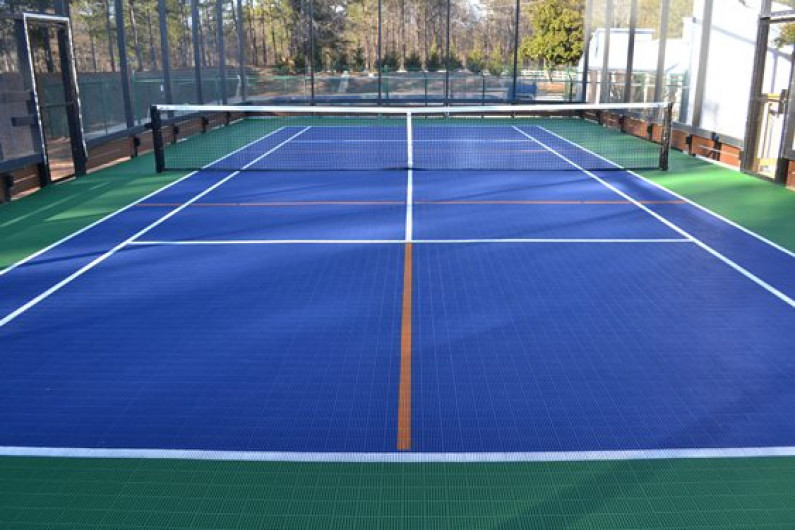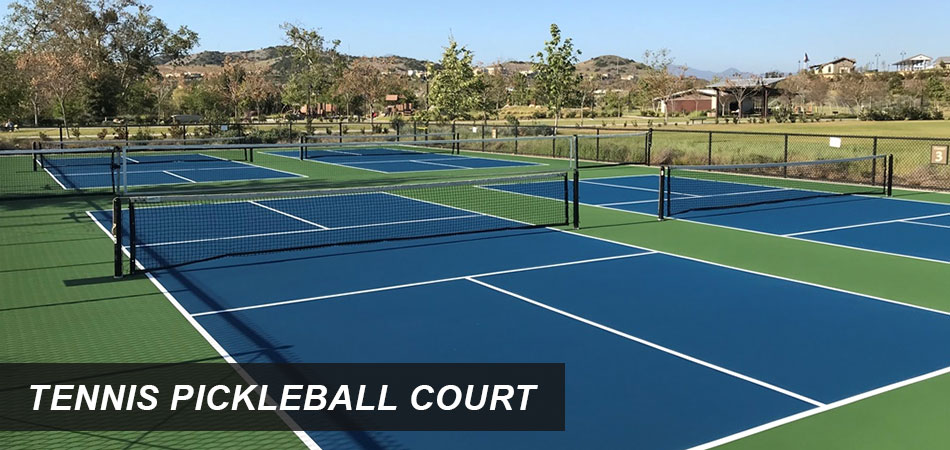A Comprehensive Guide to Designing the Perfect Pickleball Court for All Ability Levels
Designing a pickleball court that deals with gamers of varying ability levels demands a multifaceted strategy, encompassing essential elements such as court dimensions, surface products, and ease of access functions. The balance in between performance and safety and security is vital, as is the creation of a welcoming environment for both individuals and spectators. With the right design options, one can foster an engaging atmosphere that advertises satisfaction and ability advancement. Pickleball court contractor. The details entailed in achieving this equilibrium are commonly neglected. What details factors to consider must be prioritized to make sure an effective application?

Understanding Court Capacities
Recognizing the measurements of a pickleball court is crucial for both players and developers, as these specs guarantee a fair and consistent playing experience. A common pickleball court determines 20 feet broad by 44 feet long for both singles and increases play. The court is separated right into 2 equal halves by an internet that stands 36 inches high at the sidelines and 34 inches at the center.
Secret functions of the court include the non-volley area, typically referred to as the "cooking area," which prolongs 7 feet from the internet on both sides. This area is essential for regulating player movement and volleying, making certain strategic play. In addition, the service areas on each side of the court are necessary, measuring 10 feet large and 15 feet deep, created to fit proper serving methods.
Surrounding the court, a location of a minimum of 10 feet need to be assigned as the safety and security zone, enabling players adequate room to relocate and prevent injuries during play. Sticking to these dimensions not just promotes fair competition yet likewise promotes safety and enjoyment for all participants, making it vital for any type of pickleball court layout.
Picking the Right Surface Area
The selection of playing surface for a pickleball court significantly affects the video game's characteristics and player experience. Choosing the appropriate product is crucial for ensuring gamer comfort, performance, and safety and security. Usual surface areas consist of asphalt, concrete, and specialized sports floor covering.
Asphalt is a preferred choice due to its affordability and sturdiness. It offers a consistent playing surface area however can be hard on joints over extended play. Concrete, while comparable in sturdiness, provides marginal flexibility, possibly leading to boosted effect on players' bodies.
For a much more cushioned experience, lots of facilities choose specific sporting activities flooring, such as synthetic surfaces or modular tiles. These materials often consist of shock-absorbing residential properties, reducing the risk of injuries and enhancing gamer convenience. Moreover, such surface areas can improve sphere bounce uniformity, which is important for reasonable play.
When selecting a surface, think about variables such as climate, maintenance needs, and the strength of play. A well-chosen surface area not just boosts gameplay yet also adds to the durability of the court itself. Eventually, comprehending the nuances of different materials will find more info certainly aid in creating an ideal pickleball environment customized to numerous ability degrees.
Ideal Court Layout
An optimum court design is necessary for making the most of both player efficiency and viewer enjoyment in pickleball. The measurements of a standard pickleball court are 20 feet wide by 44 feet long for increases play, preserving a clear boundary that enhances gameplay. The web, positioned at 36 inches high at the sidelines and 34 inches in the center, is essential for preserving the dynamics of the video game.
Incorporating marked areas around the court for gamers to relocate freely is essential. A minimum of 10 feet of clearance on all sides of the court is recommended to stop crashes and provide area for viewers. Additionally, positioning plays a significant role; the court needs to preferably be aligned north-south to lessen the influence of sunlight glow on players during height hours.
Reliable viewer placement is similarly vital. Raised watching areas or bleachers positioned behind the sidelines can enhance the experience while making sure security. Finally, noticeable and clear court markings help in gameplay, with contrasting colors for boundaries and non-volley zones that define essential areas for gamers. Overall, a properly designed court format promotes an appealing environment for both players and viewers.

Availability Considerations
When designing a pickleball court, ensuring availability for all gamers, including those with look at this website disabilities, is extremely important. A thoughtfully designed court can cultivate inclusivity and urge involvement from people of varying capacities.

Access paths to the court need to additionally be carefully planned. Guarantee that pathways leading to the court are broad enough for wheelchair individuals and are furnished with ramps where needed. Signage should be clear and large sufficient to be conveniently reviewed.
Moreover, seating locations need to be designed to permit for very easy accessibility to and from the court. This consists of giving marked areas for spectators who may have movement challenges.
Last but not least, make sure that washroom centers close-by meet accessibility criteria. By thinking about these elements, you can produce a pickleball court that is welcoming and useful for everybody, consequently advertising a varied and vibrant neighborhood of gamers.
Maintenance and Upkeep
Correct maintenance and upkeep of a pickleball court are essential for guaranteeing optimum having fun problems and prolonging the lifespan of the facility. Normal evaluations must be performed to identify and address any damages or put on, such as splits in the surface area or loosened netting. These concerns, if left unattended, can adversely influence gameplay and safety and security.
Surface area upkeep is crucial; courts should be cleansed often to eliminate debris, leaves, or dirt that can affect traction. For tough courts, routine stress cleaning is suggested to preserve surface honesty and aesthetics. If your court is made of softer materials, such as asphalt, securing or resurfacing may be essential to secure versus weather-related wear.
Furthermore, net elevation and stress ought to be examined regularly, as inappropriate settings can modify gameplay. Preserving surrounding locations, including fence and lighting, is similarly important for making certain a risk-free and pleasurable environment.
Verdict
In verdict, the style of a suitable pickleball court demands a thorough technique that incorporates appropriate dimensions, suitable surface area materials, and thoughtful layout. By sticking to these standards, the perfect pickleball court can be created, advertising pleasure and sports growth for players of differing skill levels.
Creating a pickleball court that caters to gamers of varying ability levels requires a multifaceted strategy, encompassing essential components such as court dimensions, surface products, and ease of access attributes.Comprehending the measurements of a pickleball court is important for both gamers and designers, as these specs ensure use this link a reasonable and consistent having fun experience.The selection of playing surface for a pickleball court dramatically influences the game's dynamics and gamer experience.An optimal court layout is necessary for taking full advantage of both gamer efficiency and viewer enjoyment in pickleball. By adhering to these guidelines, the ideal pickleball court can be produced, promoting enjoyment and athletic advancement for gamers of varying ability degrees.